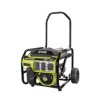Ryobi RY903600 User Manual 5 - Page 20
Maintenance
 |
View all Ryobi RY903600 manuals
Add to My Manuals
Save this manual to your list of manuals |
Page 20 highlights
MAINTENANCE n Clean any dirt from around base of spark plug. n Remove spark plug using spark plug wrench (not included). n Inspect spark plug for damage, and clean with a wire brush before reinstalling. If insulator is cracked or chipped, spark plug should be replaced. For replacement spark plug, see Product Specifications earlier in this manual or the accompanying engine manual, if applicable. n Measure plug gap. The correct gap is 0.024−0.028 in. (0.60-0.70 mm). To widen gap, if necessary, carefully bend the ground (top) electrode. To lessen gap, gently tap ground electrode on a hard surface. n Seat spark plug in position; thread in by hand to prevent cross-threading. NOTICE: Be careful not to cross-thread the spark plug. Cross- threading will seriously damage the product. n Tighten with wrench (not included) to compress washer. If spark plug is new, use 1/2 turn to compress washer appropriate amount. If reusing old spark plug, use 1/8 to 1/4 turn for proper washer compression. NOTE: An improperly tightened spark plug will become very hot and could damage the engine. CLEANING THE EXHAUST PORT AND MUFFLER Depending on the type of fuel used, the type and amount of lubricant used, and/or your operating conditions, the exhaust port and muffler may become blocked with carbon deposits. If you notice a power loss with your gas-powered products, you may need to remove these deposits to restore performance. We highly recommend that only qualified service technicians perform this service. SPARK ARRESTOR See Figure 16. NOTICE: The spark arrestor on this product has not been evaluated by the USDA Forest Service and cannot be used on U.S. forest lands. In addition, product users must comply with Federal, State, and local fire prevention regulations. Check with appropriate authorities. Contact customer service to purchase a replacement spark arrestor. The spark arrestor must be cleaned or replaced every 50 hours or yearly to ensure proper performance of your product. Spark arrestors may be in different locations depending on the model purchased. Please contact your nearest service dealer for the location of the spark arrestor for your model. To clean the spark arrestor: Loosen the screws on the rear panel. Remove rear panel and set aside. Remove the screw securing the spark arrestor in place. Remove the spark arrestor and gently clean using a wire brush. Replace the spark arrestor and rear panel. Ensure that all screws are tightened securely. DRAINING FUEL TANK/CARBURETOR See Figures 17 - 18. To help prevent gum deposits in the fuel system, drain the fuel from the tank and carburetor before storing. DRAINING THE FUEL TANK: NOTICE: Remove all lubricant from the unit before draining the fuel tank. Failure to do so could cause damage to the unit. n Remove the fuel cap. n Tilt the generator and allow fuel to drain from the fuel tank into an approved container. n When the fuel has drained from the tank, replace the fuel cap. DRAINING THE CARBURETOR: n Loosen the screw at the top of the engine maintenance cover. Remove cover and set aside. n Put the on/off switch in the OFF (O) position. n Position a suitable container under the carburetor drain screw to catch fuel; loosen the screw. n Allow fuel to drain completely into container. n Retighten drain screw securely. n Replace the engine maintenance cover and reinstall the screw to secure. NOTE: Consult hazardous waste management guidelines in your area for the proper way to dispose of used fuel. TRANSPORTING n Put the on/off switch in the OFF (O) position. n Close the vent on the fuel cap by rotating the fuel cap lever to the OFF (O) position. n Make sure engine and exhaust of unit is cool. n If transporting in a vehicle, drain the fuel tank, and securely restrain the generator. Do not drop or strike unit or place under heavy objects. 16 - English















